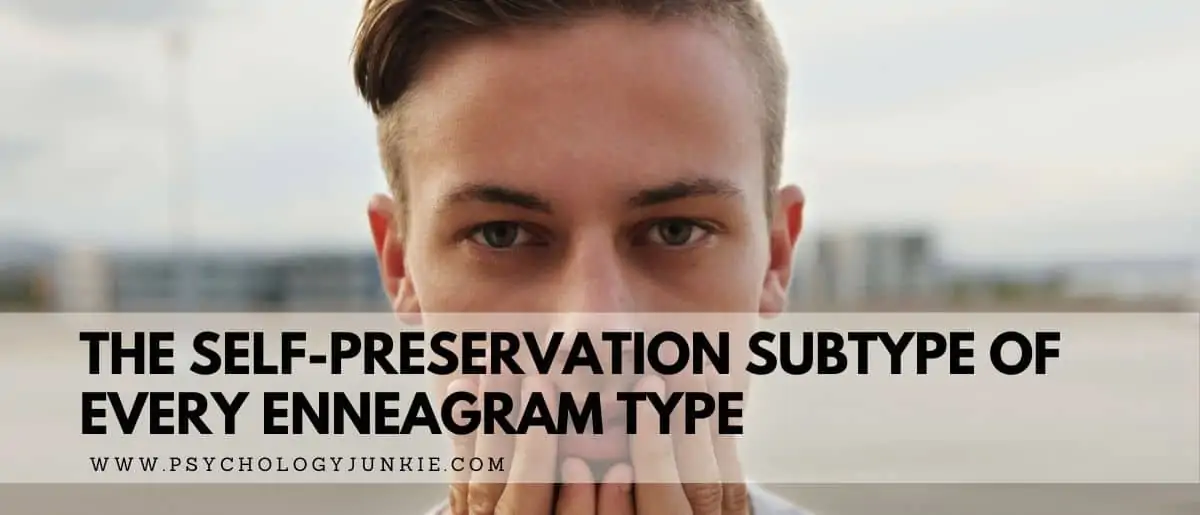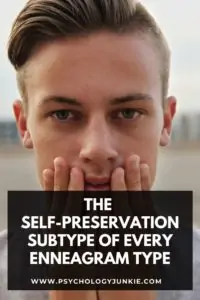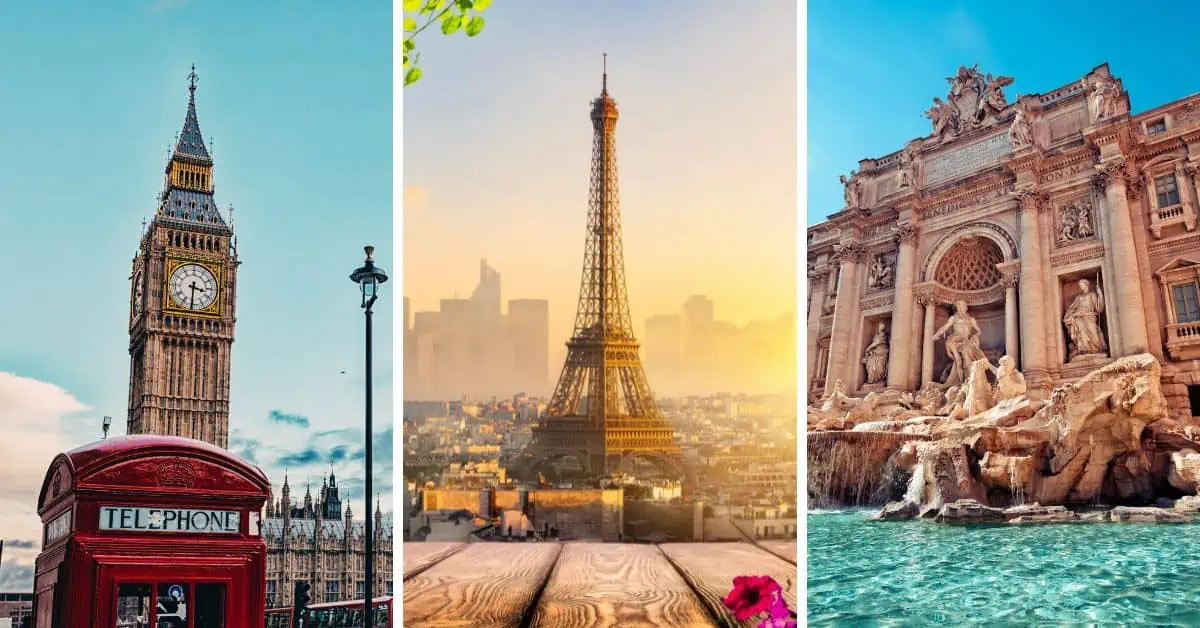The Self-Preservation Subtype of Every Enneagram Type
Self-Preservation and the Enneagram. How do these two things go together? If you’re new to the Enneagram, you might be confused about why three people with the same Enneatype can behave so very differently from each other. One Six, for example, might be warm and gentle, while the other Six seems to always be picking a fight with people. Why the differences? A lot of it boils down to subtypes.
In the Enneagram there are three subtypes for every individual Enneatype. Those subtypes are called:

- Self-Preservation
- Social
- Sexual
These subtypes may also be called “instinctual variants.” So if someone ever asks you what your “instinct” or “subtype” is, now you know what they’re talking about!
Table of contents
- What are the subtypes in the Enneagram?
- A Look at The Self-Preservation Subtype of Every Enneagram Type
- Self-Preservation 1 Enneagram Type
- Self-Preservation 2 Enneagram Type
- Self-Preservation 3 Enneagram Type
- Self-Preservation 4 Enneagram Type
- Self-Preservation 5 Enneagram Type
- Self-Preservation 6 Enneagram Type
- Self-Preservation 7 Enneagram Type
- Self-Preservation 8 Enneagram Type
- Self-Preservation 9 Enneagram Type
- What Are Your Thoughts?
Estimated reading time: 13 minutes
What are the subtypes in the Enneagram?
The subtypes add extra nuance and specificity to your Enneatype; in many ways they influence the strategies you use to get through life. While we have access to all three subtypes, one has more influence than the rest. If you’re fond of Myers-Briggs® terminology, you could say that each type has a dominant subtype, just like each Myers-Briggs® type has a dominant function.
The Self-Preservation subtype focuses on physical safety, comfort, well-being, material security, and health. People with a Self-Preservation subtype spend a great deal of time focusing on conserving material goods, energy, or resources in order to feel protected and secure in the world.
The Social subtype focuses on being liked, forming relationships, and working towards shared goals with others. People with a social subtype are focused on how others respond to them and are quick to notice their standing in a particular group. They are usually well aware of how they appear and what impact they’re having.
The Sexual subtype focuses on a spark of connection with another person. They want intense bonds and relationships and intense experiences. They seek out interactions and experiences that will make them feel alive and amped with energy and passion. They often look for relationships or friendships that complete them. Intense, deep connections are valued over a variety of more shallow connections.
It can take some time to identify which subtype is your own. Initially, I didn’t relate to the Self-Preservation subtype for myself. I didn’t consider myself someone who conserved much in the way of material goods, and I certainly wasn’t preoccupied with my health. Yet the more I examined my life over time, the more I realized that facets of self-preservation were deeply part of who I was. I’m someone who focuses intently on making sure I have enough money saved for my future, that my children are eating the right healthy foods and getting enough sleep, that when I drive somewhere I’ve mentally mapped out how to get there ahead of time. And besides that, any time I got a migraine, I had a sneaking fear that I was dying of a brain hemorrhage (I’m a self-preservation 3 by the way). These self-preservation tendencies are much more part of who I am than the social or sexual tendencies (albeit, I do have all three, and all three matter).
A Look at The Self-Preservation Subtype of Every Enneagram Type
Self-Preservation 1 Enneagram Type
Enneagram 1 Basic Desire: To have integrity. To be good.
Enneagram 1 Basic Fear: To be corrupt or evil.
This subtype of the One is plagued by worry in their daily life. They feel that if they can strive for perfection that they can finally assuage their fears and find inner peace. The self-preservation One often mistypes as the Six Enneatype, due to their anxious nature. They want to be prepared, and they will put every effort into making sure every detail of their lives is in order. At healthy levels, this One is conscientious, ethical, highly principled, and honest. At unhealthy levels, they are self-righteous, overly perfectionistic, nitpicky, and inflexible.
Key Characteristics of the Self-Preservation One Enneatype:
- Strives for perfection
- Driven to worry and fret over everything
- Often hides resentment or anger
- Kind and gentle (when at healthy to average levels of health)
- Focuses on predicting the future
- Often a control freak over their own life
- Tends to be hard on themselves
- Plans everything out
- Feels an excessive amount of responsibility
- Aims to be tolerant, forgiving, and compassionate
Self-Preservation 2 Enneagram Type
Enneagram 2 Basic Desire: To be loved for who they are
Enneagram 2 Basic Fear: To be unloved or unwanted
Tender and sweet, this subtype of the Two is the most difficult to identify. They appear playful, cute, and even childlike in order to gain security and approval. Unconsciously they realize that by being this way they may be able to receive protection and love as a byproduct. More fearful and less trusting than the average Two, they try to meet others’ needs in order to gain approval, but they also try to pull back from people because they fear rejection, judgment, or failure. At healthy levels, this Two is unselfish, altruistic, empathetic, and giving. At unhealthy levels, they are resentful, selfish, undermining, and only give to get something in return.
Key Characteristics of the Self-Preservation Two Enneatype:
- They are playful and winsome
- They want to be taken care of, but fear depending on others
- They become hurt and withdrawn when they fear rejection
- They are more guarded than the other two subtypes of the Two
- They are drawn to pleasure and fun
- They may mistype, or look like, Sevens
- They seek to be loved just because they exist
- They express emotionality and tenderness
- They idealize people, especially at the beginning of relationships
Self-Preservation 3 Enneagram Type
Enneagram 3 Basic Desire: To be successful and desired
Enneagram 3 Basic Fear: To be a failure or worthless, without achievement
Threes of this subtype believe in working hard to maintain their own security as well as take care of others. They are highly autonomous and don’t want to feel beholden to anyone. While they often appear calm, prepared, and competent on the outside, they often harbor inner anxieties that they fail to express verbally. To this Three, being the “best” is a huge focus. They want to be the best at their job, the best at parenting, the best spouse. But even though they work so hard at being the best, they strive to appear modest. They don’t want others to know that they want admiration, because that would make them vain and therefore not “best.” They may not even be aware of their own need for affirmation in this area. They usually have a strong code of honor and a need to work hard and be self-reliant. At healthy levels, this Three is goal-oriented, dedicated, persevering, modest, charitable, and encouraging. At unhealthy levels, this Three is falsely modest, prone to workaholism, superficial, dismissive, and rigid.
Key Characteristics of the Self-Preservation Three Enneatype:
- Works hard and tirelessly
- Wants to be the best
- Can mistype as a One or Six
- Values security and works hard to achieve it
- Wants to earn admiration through merit, without any shortcuts
- Doesn’t want to want to be noticed, but wants it anyway (was that confusing?)
- Avoids talking about their successes and achievements
Self-Preservation 4 Enneagram Type
Enneagram 4 Basic Desire: To have a sense of identity and to be authentic to themselves
Enneagram 4 Basic Fear: To have no identity and flawed
While Envy is the weakness of all Fours, the Self-Preservation Four focuses less on dwelling in envy and more on attaining the objects of their desire. Endurance is a quality they embrace and they will scale any wall in order to achieve the things their hearts long for. These types put high demands on themselves and will work hard in order to own the things that make them feel the most authentic and alive. Their homes, in particular, are often adorned with decorations and accents that are tailored to their unique tastes. They often feel a sense of pride for how much they can endure or how hard they can work. Because of their persistent, goal-oriented nature, they often look like Ones or Threes.
Healthy Fours are resilient, creative, life-embracing, introspective, empathetic, and self-aware. Unhealthy Fours are self-rejecting, melancholy, self-absorbed and temperamental.
Key Characteristics of the Self-Preservation Four Enneatype:
- They crave struggle and pride themselves in their suffering and tolerance for it
- They work hard to gain the things they want
- They value resilience and determination
- They dislike complaining
- They are often empathetic and compassionate
- They hope that others will love them because of their steadfastness and strength
- They feel intense and nuanced emotions, but may not verbalize them
Self-Preservation 5 Enneagram Type
Enneagram 5 Basic Desire: To be competent and knowledgeable
Enneagram 5 Basic Fear: To be incompetent and without resources
Fives of this subtype build thick boundaries between themselves and others so that they can feel safe. They believe that if they separate themselves from others and reduce their needs they can be autonomous and secure. They are highly aware of their energy levels and try not to spend too much energy on commitments or obligations. They don’t want to need others or be needed too much. In turn, they take little from the world and fiercely protect the few things they value. In relationships, these Fives avoid creating expectations and avoid being under someone else’s thumb. Healthy Fives are visionary, competent, and profound – compassionately trying to understand their world and their place in it. They respect the space and needs of others and don’t take from others without giving back in equal supply. Unhealthy Fives are nihilistic, stingy, and isolated, unwilling to open up to others or do anything for fear that they’ll be overwhelmed.
Key Characteristics of the Self-Preservation Five Enneatype:
- They are intensely private
- They would rather withdraw than express their anger or uncomfortable feelings
- They are often introverted
- They may blend in with the people around them so as not to be seen
- They see the external world as hostile, overwhelming, and intrusive
- They put a lot of boundaries between themselves and the outside world
- They limit their needs and expectations, getting by on very little
Self-Preservation 6 Enneagram Type
Enneagram 6 Basic Desire: To have security and guidance
Enneagram 6 Basic Fear: To be unsupported and unprepared
As the most phobic subtype, this Six looks for security through mutual responsibility. They take their commitments very seriously, hoping to form strong alliances as a result. Often very practical, they keep their finances in check, their bills paid, and the future organized and planned out. This Six often fears for their survival and hopes that if they make the right connections with others they will finally be able to rest. They are often warm and generous, but underneath their friendly demeanor is a deep anxiety that if they don’t keep up their alliances they will be attacked, rejected, and left alone and vulnerable. These Sixes feel a tremendous amount of indecision and skepticism; everything is gray, nothing is black and white. They doubt themselves and others and are frequently lost in analysis-paralysis.
Sixes that are healthy are courageous, self-reliant, grounded, and friendly. They trust themselves and feel secure, serene, and connected to the world around them. Unhealthy Sixes are panicky, paranoid, self-destructive, and unreliable. They test people, create “us vs. them” scenarios, and often feel depressed and helpless.
Key Characteristics of the Self-Preservation Six Enneatype:
- Oriented towards relationships and interpersonal connections
- Craves= outside support
- Skeptical and doubtful
- Warm and friendly
- Fear letting other people down or disappointing them
- Often mistypes as a Two Enneatype
- Feel a lot of responsibility and guilt
- Struggle to make decisions
Self-Preservation 7 Enneagram Type
Enneagram 7 Basic Desire: To have freedom and happiness
Enneagram 7 Basic Fear: To be trapped, in pain, to miss out
Practical and opportunistic, the Self-Preservation Seven is always on the lookout for deals and possibilities that will ensure their survival. They enjoy collecting material things in an effort to feel secure and safe. This can show up in a love of browsing deal websites or an interest in the newest, best iPhone or tablet. These Sevens are energetic, charming, and driven – working hard to form connections and grab opportunities that will build up their safety and be a buffer against boredom or pain. Unhealthy Self-Preservation Sevens are manipulative, greedy, demanding, and reckless. Healthy Self-Preservation Sevens are content with what they have, enthusiastic, realistic, and inspiring.
Key Characteristics of the Self-Preservation Seven Enneatype:
- They are practical and realistic
- They form a group of allies or supporters
- They are opportunistic
- They enjoy having the best and newest material things
- They are talkative and charming
- They have a good sense of humor
- They are skilled at networking
- They can get very demanding and irritable when their physical needs aren’t met
Self-Preservation 8 Enneagram Type
Enneagram 8 Basic Desire: To be in control and have autonomy
Enneagram 8 Basic Fear: To be controlled or vulnerable
No-nonsense and practical, these Eights will do what it takes to make sure their needs are met (and the needs of their loved ones). They will cut past pretense and formalities to get straight to the point in a conversation, often shunning frivolous chit-chat or small talk. That said, they don’t reveal much about themselves and often seem mysterious and cunning. They often look for symbols of their power and impact; fancy cars, nice houses, power suits, or other things.
Unhealthy Eights can be bullies, stopping at nothing to get what they want. They can also be selfish, impatient, and prone to workaholism. Healthy Eights are heroic, self-reliant, strong, and protective of others. They have a knack for bringing out others’ strengths and motivating people to go for their dreams.
Key Characteristics of the Self-Preservation Eight Enneatype:
- No-nonsense and straightforward
- Practical and realistic
- Goes for what they want
- Private and mysterious to many
- Direct in communication
- Productive and hard-working
- Can be mistaken for a type One
- Exudes a quiet strength
Self-Preservation 9 Enneagram Type
Enneagram 9 Basic Desire: To have inner peace and stability
Enneagram 9 Basic Fear: To have inner conflict and fragmentation
Practical and routine-oriented, this Nine is less drawn to imagination and conceptual ideas than the other Nine subtypes. Instead, they focus on the present and find ways to make it more enjoyable and comfortable. Creature comforts are an attraction to this Nine, and they often find joy through favorite foods, television shows, and books that they revisit time and time again to feel secure. They may be quite talented, but their focus on the immediate and minor rewards may keep them from pursuing their bigger ambitions and dreams. At unhealthy levels, the Self-Preservation Nine is apathetic, ineffectual, and emotionally shut down. They often become hooked on their comfortable routines and habits and blind to what’s really happening around them. At healthy levels, they are practical, unselfish, peaceful, level-headed, and patient.
Key Characteristics of the Self-Preservation Nine Enneatype:
- Focused on the real, concrete world
- Need a lot of alone time
- Often have wry, self-deprecating sense of humor
- May use food or drink to suppress anxiety
- Seeks physical comfort
- Enjoys a predictable routine
- Fun-loving and accepting
- Can be highly stubborn and irritable
What Are Your Thoughts?
Did you enjoy this article? Do you have any questions or insights? Be sure to let us know in the comments! Stay tuned for future articles about the Sexual and Social subtypes of each Enneagram type!
Other Articles You Might Enjoy:
The Emotional Patterns of Each Enneagram Type
Why Each Enneagram Type Feels Trapped
Here’s What You Fear, Based On Your Enneagram Type

Subscribe to Our Newsletter

Want to discover more about personality type? Get the inside scoop with Susan Storm on all things typological, along with special subscriber freebies, and discounts on new eBooks and courses! Join our newsletter today!













What a wonderful article! I’m a self-preservation 9. :).
Thank you Kristi!!
“If you’re fond of Myers-Briggs® terminology, you could say that each type has a dominant subtype, just like each Myers-Briggs® type has a dominant function.”
Is this a good analogy though?
For each enneatype, you can have each subtype, while for MBTI, it’s always the same dominant function for said type. I think it might be more confusing than helping for people who are not familiar with it, no?
Ugh I know this is my instinct, and I was so sure I was a seven, but I don’t relate with self-preservation seven at all! I relate strongly to self-preservation nine, which might be me. I just don’t know how to tell if I’m other referenced or self referenced. I feel like I look at both.